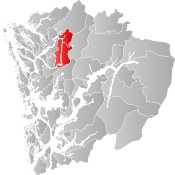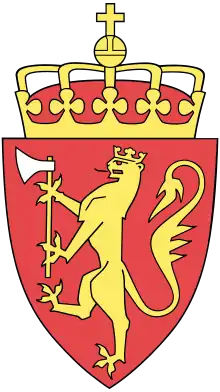Bruvik (municipality)
Bruvik is a former municipality in the old Hordaland county, Norway. The municipality existed from 1870 until its dissolution in 1964. At the time of its dissolution, the municipality covered 391 square kilometres (151 sq mi) on both sides of the Veafjorden, the innermost part of the Sørfjorden, including the southeastern part of the island of Osterøy. The administrative centre of the municipality was the village of Bruvik where Bruvik Church is located.[2]
Bruvik herad | |
|---|---|
 Bruvik on Osterøy island, seen from the top of Brøknipa | |
 Coat of arms  Hordaland within Norway | |
 Bruvik within Hordaland | |
| Coordinates: 60°28′50″N 05°41′00″E | |
| Country | Norway |
| County | Hordaland |
| District | Nordhordland |
| Established | 1 Jan 1870 |
| Disestablished | 1 Jan 1964 |
| Administrative centre | Bruvik |
| Government | |
| • Mayor (1960-1963) | Jan Hermann Hermansen |
| Area | |
| • Total | 391 km2 (151 sq mi) |
| *Area at municipal dissolution. | |
| Population (1963) | |
| • Total | 5,673 |
| • Density | 15/km2 (38/sq mi) |
| Demonym(s) | Bruviking[1] |
| Time zone | UTC+01:00 (CET) |
| • Summer (DST) | UTC+02:00 (CEST) |
| ISO 3166 code | NO-1251 |
| Preceded by | Haus in 1870 |
| Succeeded by | Vaksdal and Osterøy in 1964 |
History
The parish of Haus was established as a municipality on 1 January 1838 (see formannskapsdistrikt law). On 1 January 1870, the northeastern district of Haus (population: 2,062) was separated from Haus to form the new municipality of Bruvik.
During the 1960s, there were many municipal mergers across Norway due to the work of the Schei Committee. On 1 January 1964, the municipality of Bruvik was dissolved and its lands were split up as follows:[3]
- the area around the village of Bruvik on the island of Osterøy (population: 409) was merged with parts of the municipalities of Haus (population: 2,237), Hamre (population: 1,166), and Hosanger (population: 1,616) to create the new Osterøy Municipality.
- the rest of Bruvik (population: 5,264), was merged with a parts of the municipalities of Evanger (population: 251) and Modalen (population: 151) to create the new Vaksdal Municipality.
Municipal council
The municipal council (Heradsstyre) of Bruvik was made up of 37 representatives that were elected to four year terms. The party breakdown of the final municipal council was as follows:
| Party Name (in Nynorsk) | Number of representatives | |
|---|---|---|
| Labour Party (Arbeidarpartiet) | 20 | |
| Christian Democratic Party (Kristeleg Folkeparti) | 7 | |
| Liberal Party (Venstre) | 6 | |
| Local List(s) (Lokale lister) | 4 | |
| Total number of members: | 37 | |
| Party Name (in Nynorsk) | Number of representatives | |
|---|---|---|
| Labour Party (Arbeidarpartiet) | 22 | |
| Christian Democratic Party (Kristeleg Folkeparti) | 4 | |
| Farmers' Party (Bondepartiet) | 2 | |
| Local List(s) (Lokale lister) | 9 | |
| Total number of members: | 37 | |
| Party Name (in Nynorsk) | Number of representatives | |
|---|---|---|
| Labour Party (Arbeidarpartiet) | 20 | |
| Joint List(s) of Non-Socialist Parties (Borgarlege Felleslister) | 13 | |
| Local List(s) (Lokale lister) | 3 | |
| Total number of members: | 36 | |
| Party Name (in Nynorsk) | Number of representatives | |
|---|---|---|
| Labour Party (Arbeidarpartiet) | 17 | |
| Communist Party (Kommunistiske Parti) | 3 | |
| Local List(s) (Lokale lister) | 16 | |
| Total number of members: | 36 | |
| Party Name (in Nynorsk) | Number of representatives | |
|---|---|---|
| Labour Party (Arbeidarpartiet) | 16 | |
| Communist Party (Kommunistiske Parti) | 4 | |
| List of workers, fishermen, and small farmholders (Arbeidarar, fiskarar, småbrukarar liste) | 3 | |
| Local List(s) (Lokale lister) | 13 | |
| Total number of members: | 36 | |
| Party Name (in Nynorsk) | Number of representatives | |
|---|---|---|
| Labour Party (Arbeidarpartiet) | 11 | |
| Liberal Party (Venstre) | 5 | |
| Joint List(s) of Non-Socialist Parties (Borgarlege Felleslister) | 11 | |
| Local List(s) (Lokale lister) | 9 | |
| Total number of members: | 36 | |
Coat of arms
The coat of arms was granted on 14 December 1960. The blue and white arms show a chevron symbol above a cogwheel which symbolizes industry. In 1964 when Bruvik municipality was dissolved, the new municipality of Vaksdal (which included the majority of the old Bruvik municipality) chose to continue using the old arms of Bruvik. Vaksdal used the arms until 1990 when new arms were adopted.[10]
References
- "Navn på steder og personer: Innbyggjarnamn" (in Norwegian). Språkrådet.
- Store norske leksikon. "Bruvik" (in Norwegian). Retrieved 2014-04-23.
- Jukvam, Dag (1999). "Historisk oversikt over endringer i kommune- og fylkesinndelingen" (PDF) (in Norwegian). Statistisk sentralbyrå.
- "Kommunevalgene og Ordførervalgene 1959" (PDF) (in Norwegian). Oslo: Statistisk sentralbyrå. 1960. Retrieved 2020-02-15.
- "Kommunevalgene og Ordførervalgene 1955" (PDF) (in Norwegian). Oslo: Statistisk sentralbyrå. 1957. Retrieved 2020-02-16.
- "Kommunevalgene og Ordførervalgene 1951" (PDF) (in Norwegian). Oslo: Statistisk sentralbyrå. 1952. Retrieved 2020-02-16.
- "Kommunevalgene og Ordførervalgene 1947" (PDF) (in Norwegian). Oslo: Statistisk sentralbyrå. 1948. Retrieved 2020-02-16.
- "Kommunevalgene og Ordførervalgene 1945" (PDF) (in Norwegian). Oslo: Statistisk sentralbyrå. 1947. Retrieved 2020-02-16.
- "Kommunevalgene og Ordførervalgene 1937" (PDF) (in Norwegian). Oslo: Statistisk sentralbyrå. 1938. Retrieved 2020-05-16.
- "Civic heraldry of Norway - Norske Kommunevåpen". Heraldry of the World. Retrieved 2020-02-09.

